Investigation of the Magnetosphere of Ganymede with Galileo's Energetic Particle Detector
Ph.D. dissertation by Shawn M. Stone, University of Kansas,
1999.
Copyright 1999 by Shawn M. Stone. Used with permission.
6.4.2 Feature G2-19:10:51 (continued)
For model M2 the trajectory pointed out in Figure 6.128 is broken down into subenergies of which Figure 6.136 shows the collimator pitch and phase angle scatter plot for subenergy 400 keV. Sublook 10 is chosen for detailed tracing. The results of the trace are presented in Figures 6.137 through 6.142 and are summarized in Table 6.12. This particle with the same pitch and phase impacts the surface of Ganymede and is absorbed. The magnitude and pitch angle of the M2 ion at the third sample is 220 nT and 23° which gives a bounce field strength of 1400 nT. An inspection of Figure 6.139a shows the surface strength on the surface where this field line touches is 1100 nT. The field geometry is important in regions external to Ganymede.
 |
Figure 6.136 Collimator pitch and phase scatter plot for the sector pointed out in Figure 6.128 for M2 A4 G2-19:10:51 subenergy 400 keV. The angles are in degrees. The filled in squares represent trajectories that intersected the surface of Ganymede and were absorbed. Open squares are trajectories that missed. |
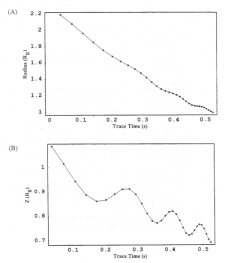 |
Figure 6.137 (A) Length of the radius vector from the center of Ganymede to the particle as a function of trace time in seconds for subenergy 400 keV sublook direction 10 for model M2 channel A4. (B) The Z component of the particle position in GSII coordinates for subenergy 400 keV sublook direction 10 for model M2 channel A4. |
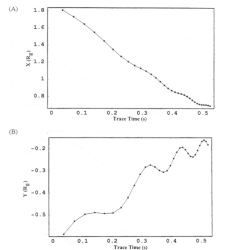 |
Figure 6.138 (A) The X component of the particle position in GSII coordinates for subenergy 400 keV sublook direction 10 for model M2 channel A4. (B) The Y component of the particle position in GSII coordinates for subenergy 400 keV sublook direction 10 for model M2 channel A4. |
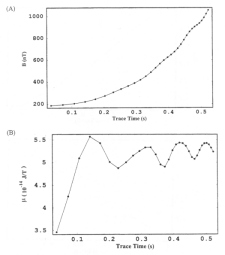 |
Figure 6.139 (A) Magnetic field at the location of the particle as a function of trace time for subenergy 400 keV sublook direction 10 for model M2 channel A4. (B) Magnetic moment at the location of the particle as a function of trace time for subenergy 400 keV sublook direction 10 for model M2 channel A4. |
 |
Figure 6.140 (A) Velocity of the particle as a function of trace time for subenergy 400 keV sublook direction 10 for model M2 channel A4. (B) Pitch angle of the particle as a function of trace time for subenergy 400 keV sublook direction 10 for model M2 channel A4. |
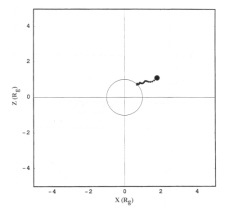 |
Figure 6.141 (A) ZX projection of the trajectory for subenergy 400 keV sublook direction 10 for model M2 channel A4. |
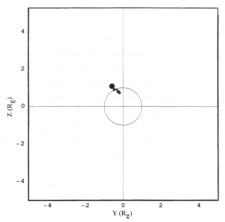 |
Figure 6.142 ZY projection of the trajectory for subenergy 400 keV sublook direction 10 for model M2 channel A4. |
Table 6.12 Summary of the time-reversed particle trace presented in Figures 6.137 through 6.142 for subenergy 400 keV sublook direction 10 for model M2 channel A4.
| Figure | Information | Observation |
| 6.137 | (A) Radius of particle from Ganymede. (B) Z component of particle trajectory. | The ion moves along the field line and impacts Ganymede. |
| 6.138 | (A) X component of particle trajectory. (B) Y component of particle trajectory | The ion moves along the field line and impacts Ganymede. |
| 6.139 | (A) Magnetic field sampled by the particle. (B) Magnetic moment sampled by the particle. | The magnetic field grows steadily to a maximum value of 1000 nT and then impacts Ganymede. The magnetic moment shows a gyrophase averaged value of .5H10-14 J/T. |
| 6.140 | (A) Speed of the particle as it moves through its trajectory. (B) Pitch angle of the particle. | The speed of the ion remains constant throughout the trajectory. The pitch angle steadily increases uniformly from .37 to 1.2 radians just before it impacts the surface. |
| 6.141 | ZX projection of the trajectory of the particle. | The ion is shown impacting Ganymede. |
| 6.142 | ZY projection of the trajectory of the particle. | The ion is shown impacting Ganymede. |
Return to dissertation table of contents page.
Return to main
Galileo Table of Contents Page.
Return to Fundamental
Technologies Home Page.
Updated 8/23/19, Cameron Crane
QUICK FACTS
Mission Duration: Galileo was planned to have a mission duration of around 8 years, but was kept in operation for 13 years, 11 months, and 3 days, until it was destroyed in a controlled impact with Jupiter on September 21, 2003.
Destination: Galileo's destination was Jupiter and its moons, which it orbitted for 7 years, 9 months, and 13 days.



